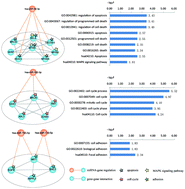当前位置:
X-MOL 学术
›
Mol. Biosyst.
›
论文详情
Our official English website, www.x-mol.net, welcomes your
feedback! (Note: you will need to create a separate account there.)
A systems biology approach to identify microRNAs contributing to cisplatin resistance in human ovarian cancer cells
Molecular BioSystems Pub Date : 2017-08-15 00:00:00 , DOI: 10.1039/c7mb00362e Weisha Liu 1, 1, 2, 3, 4 , Shuyuan Wang 2, 3, 4, 5 , Shunheng Zhou 2, 3, 4, 5 , Feng Yang 2, 3, 4, 5 , Wei Jiang 2, 3, 4, 5 , Qingyuan Zhang 1, 1, 2, 3, 4 , Lihong Wang 1, 1, 2, 3, 4
Molecular BioSystems Pub Date : 2017-08-15 00:00:00 , DOI: 10.1039/c7mb00362e Weisha Liu 1, 1, 2, 3, 4 , Shuyuan Wang 2, 3, 4, 5 , Shunheng Zhou 2, 3, 4, 5 , Feng Yang 2, 3, 4, 5 , Wei Jiang 2, 3, 4, 5 , Qingyuan Zhang 1, 1, 2, 3, 4 , Lihong Wang 1, 1, 2, 3, 4
Affiliation

|
Cisplatin (CDDP)-based chemotherapy is a standard first-line therapy for ovarian cancer. However, drug resistance remains a major obstacle to its efficacy. Recently, increasing evidence suggested that the aberrant expression of microRNAs (miRNAs) may contribute to drug resistance. Here, we proposed a systems biology analysis strategy to identify the novel miRNAs potentially involved in CDDP resistance in human ovarian cancer cells. Firstly, we identified the candidate miRNAs associated with CDDP resistance using NCI-60 data. Next, the differentially expressed genes (DEGs) in the CDDP-resistant ovarian cancer cell line OVCAR-8R were obtained. After mapping the DEGs to a human protein–protein interaction network, a CDDP resistance-related sub-network for ovarian cancer was constructed, and subsequently the functional gene modules were identified. Then, based on the experimentally validated miRNA regulations to target genes, 4 candidate miRNAs (miR-24-3p, miR-192-5p, miR-139-5p and miR-155-5p) were identified to potentially contribute to ovarian cancer cell chemoresistance to CDDP through mediating OVCAR-8R cell CDDP resistance-related gene modules, which participated in functions that were closely related to “apoptosis”, “cell cycle” and “adhesion”. In addition, we predicted the therapeutic drugs that might reduce or reverse CDDP resistance by targeting these 4 identified miRNAs. This study revealed the underlying mechanism of CDDP resistance, and provided novel potential drug targets and therapeutics for CDDP-resistant ovarian cancer patients.
中文翻译:

一种系统生物学方法,用于鉴定有助于人类卵巢癌细胞中顺铂耐药的微小RNA
基于顺铂(CDDP)的化学疗法是卵巢癌的标准一线疗法。然而,耐药性仍然是其功效的主要障碍。最近,越来越多的证据表明,microRNA(miRNA)的异常表达可能有助于耐药性。在这里,我们提出了一种系统生物学分析策略,以鉴定可能参与人类卵巢癌细胞CDDP抗性的新型miRNA。首先,我们使用NCI-60数据鉴定了与CDDP抗性相关的候选miRNA。接下来,获得了抗CDDP的卵巢癌细胞系OVCAR-8R中的差异表达基因(DEG)。在将DEGs映射到人类蛋白质-蛋白质相互作用网络后,构建了CDDP耐药性卵巢癌子网络,随后鉴定了功能基因模块。然后,根据经过实验验证的针对靶基因的miRNA法规,确定了4种候选miRNA(miR-24-3p,miR-192-5p,miR-139-5p和miR-155-5p)可能对卵巢癌细胞有贡献通过介导OVCAR-8R细胞CDDP耐药相关基因模块对CDDP的化学耐药性,这些模块参与了与“细胞凋亡”,“细胞周期”和“粘附”密切相关的功能。此外,我们通过靶向这4种已鉴定的miRNA预测了可能降低或逆转CDDP耐药性的治疗药物。这项研究揭示了CDDP耐药的潜在机制,并为CDDP耐药的卵巢癌患者提供了新的潜在药物靶标和治疗方法。通过介导OVCAR-8R细胞CDDP耐药相关基因模块介导OVCAR-8R细胞CDDP耐药相关基因模块,发现miR-139-5p和miR-155-5p可能有助于卵巢癌细胞对CDDP的化学抗性, “细胞周期”和“粘附”。此外,我们通过靶向这4种已鉴定的miRNA预测了可能降低或逆转CDDP耐药性的治疗药物。这项研究揭示了CDDP耐药的潜在机制,并为CDDP耐药的卵巢癌患者提供了新的潜在药物靶标和治疗方法。通过介导OVCAR-8R细胞CDDP耐药相关基因模块介导OVCAR-8R细胞CDDP耐药相关基因模块,发现miR-139-5p和miR-155-5p可能有助于卵巢癌细胞对CDDP的化学抗性, “细胞周期”和“粘附”。此外,我们通过靶向这4种已鉴定的miRNA预测了可能降低或逆转CDDP耐药性的治疗药物。这项研究揭示了CDDP耐药的潜在机制,并为CDDP耐药的卵巢癌患者提供了新的潜在药物靶标和治疗方法。此外,我们通过靶向这4种已鉴定的miRNA预测了可能降低或逆转CDDP耐药性的治疗药物。这项研究揭示了CDDP耐药的潜在机制,并为CDDP耐药的卵巢癌患者提供了新的潜在药物靶标和治疗方法。此外,我们通过靶向这4种已鉴定的miRNA预测了可能降低或逆转CDDP耐药性的治疗药物。这项研究揭示了CDDP耐药的潜在机制,并为CDDP耐药的卵巢癌患者提供了新的潜在药物靶标和治疗方法。
更新日期:2017-09-04
中文翻译:

一种系统生物学方法,用于鉴定有助于人类卵巢癌细胞中顺铂耐药的微小RNA
基于顺铂(CDDP)的化学疗法是卵巢癌的标准一线疗法。然而,耐药性仍然是其功效的主要障碍。最近,越来越多的证据表明,microRNA(miRNA)的异常表达可能有助于耐药性。在这里,我们提出了一种系统生物学分析策略,以鉴定可能参与人类卵巢癌细胞CDDP抗性的新型miRNA。首先,我们使用NCI-60数据鉴定了与CDDP抗性相关的候选miRNA。接下来,获得了抗CDDP的卵巢癌细胞系OVCAR-8R中的差异表达基因(DEG)。在将DEGs映射到人类蛋白质-蛋白质相互作用网络后,构建了CDDP耐药性卵巢癌子网络,随后鉴定了功能基因模块。然后,根据经过实验验证的针对靶基因的miRNA法规,确定了4种候选miRNA(miR-24-3p,miR-192-5p,miR-139-5p和miR-155-5p)可能对卵巢癌细胞有贡献通过介导OVCAR-8R细胞CDDP耐药相关基因模块对CDDP的化学耐药性,这些模块参与了与“细胞凋亡”,“细胞周期”和“粘附”密切相关的功能。此外,我们通过靶向这4种已鉴定的miRNA预测了可能降低或逆转CDDP耐药性的治疗药物。这项研究揭示了CDDP耐药的潜在机制,并为CDDP耐药的卵巢癌患者提供了新的潜在药物靶标和治疗方法。通过介导OVCAR-8R细胞CDDP耐药相关基因模块介导OVCAR-8R细胞CDDP耐药相关基因模块,发现miR-139-5p和miR-155-5p可能有助于卵巢癌细胞对CDDP的化学抗性, “细胞周期”和“粘附”。此外,我们通过靶向这4种已鉴定的miRNA预测了可能降低或逆转CDDP耐药性的治疗药物。这项研究揭示了CDDP耐药的潜在机制,并为CDDP耐药的卵巢癌患者提供了新的潜在药物靶标和治疗方法。通过介导OVCAR-8R细胞CDDP耐药相关基因模块介导OVCAR-8R细胞CDDP耐药相关基因模块,发现miR-139-5p和miR-155-5p可能有助于卵巢癌细胞对CDDP的化学抗性, “细胞周期”和“粘附”。此外,我们通过靶向这4种已鉴定的miRNA预测了可能降低或逆转CDDP耐药性的治疗药物。这项研究揭示了CDDP耐药的潜在机制,并为CDDP耐药的卵巢癌患者提供了新的潜在药物靶标和治疗方法。此外,我们通过靶向这4种已鉴定的miRNA预测了可能降低或逆转CDDP耐药性的治疗药物。这项研究揭示了CDDP耐药的潜在机制,并为CDDP耐药的卵巢癌患者提供了新的潜在药物靶标和治疗方法。此外,我们通过靶向这4种已鉴定的miRNA预测了可能降低或逆转CDDP耐药性的治疗药物。这项研究揭示了CDDP耐药的潜在机制,并为CDDP耐药的卵巢癌患者提供了新的潜在药物靶标和治疗方法。









































 京公网安备 11010802027423号
京公网安备 11010802027423号